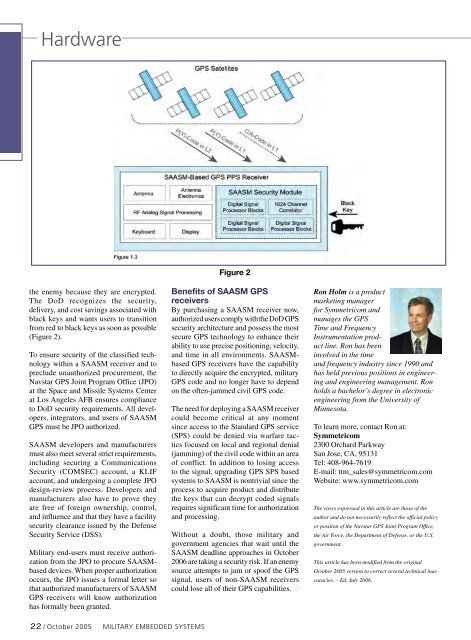Military Embedded Systems - Fall 2005 - Volume 1 Number 2
Military Embedded Systems - Fall 2005 - Volume 1 Number 2
Military Embedded Systems - Fall 2005 - Volume 1 Number 2
Create successful ePaper yourself
Turn your PDF publications into a flip-book with our unique Google optimized e-Paper software.
Hardware<br />
the enemy because they are encrypted.<br />
The DoD recognizes the security,<br />
delivery, and cost savings associated with<br />
black keys and wants users to transition<br />
from red to black keys as soon as possible<br />
(Figure 2).<br />
To ensure security of the classified technology<br />
within a SAASM receiver and to<br />
preclude unauthorized procurement, the<br />
Navstar GPS Joint Program Office (JPO)<br />
at the Space and Missile <strong>Systems</strong> Center<br />
at Los Angeles AFB ensures compliance<br />
to DoD security requirements. All developers,<br />
integrators, and users of SAASM<br />
GPS must be JPO authorized.<br />
SAASM developers and manufacturers<br />
must also meet several strict requirements,<br />
including securing a Communications<br />
Security (COMSEC) account, a KLIF<br />
account, and undergoing a complete JPO<br />
design-review process. Developers and<br />
manufacturers also have to prove they<br />
are free of foreign ownership, control,<br />
and influence and that they have a facility<br />
security clearance issued by the Defense<br />
Security Service (DSS).<br />
<strong>Military</strong> end-users must receive authorization<br />
from the JPO to procure SAASMbased<br />
devices. When proper authorization<br />
occurs, the JPO issues a formal letter so<br />
that authorized manufacturers of SAASM<br />
GPS receivers will know authorization<br />
has formally been granted.<br />
Figure 2<br />
Benefits of SAASM GPS<br />
receivers<br />
By purchasing a SAASM receiver now,<br />
authorized users comply with the DoD GPS<br />
security architecture and possess the most<br />
secure GPS technology to enhance their<br />
ability to use precise positioning, velocity,<br />
and time in all environments. SAASMbased<br />
GPS receivers have the capability<br />
to directly acquire the encrypted, military<br />
GPS code and no longer have to depend<br />
on the often-jammed civil GPS code.<br />
The need for deploying a SAASM receiver<br />
could become critical at any moment<br />
since access to the Standard GPS service<br />
(SPS) could be denied via warfare tactics<br />
focused on local and regional denial<br />
(jamming) of the civil code within an area<br />
of conflict. In addition to losing access<br />
to the signal, upgrading GPS SPS based<br />
systems to SAASM is nontrivial since the<br />
process to acquire product and distribute<br />
the keys that can decrypt coded signals<br />
requires significant time for authorization<br />
and processing.<br />
Without a doubt, those military and<br />
government agencies that wait until the<br />
SAASM deadline approaches in October<br />
2006 are taking a security risk. If an enemy<br />
source attempts to jam or spoof the GPS<br />
signal, users of non-SAASM receivers<br />
could lose all of their GPS capabilities.<br />
Ron Holm is a product<br />
marketing manager<br />
for Symmetricom and<br />
manages the GPS<br />
Time and Frequency<br />
Instrumentation product<br />
line. Ron has been<br />
involved in the time<br />
and frequency industry since 1990 and<br />
has held previous positions in engineering<br />
and engineering management. Ron<br />
holds a bachelor’s degree in electronic<br />
engineering from the University of<br />
Minnesota.<br />
To learn more, contact Ron at:<br />
Symmetricom<br />
2300 Orchard Parkway<br />
San Jose, CA, 95131<br />
Tel: 408-964-7619<br />
E-mail: ttm_sales@symmetricom.com<br />
Website: www.symmetricom.com<br />
The views expressed in this article are those of the<br />
author and do not necessarily reflect the official policy<br />
or position of the Navstar GPS Joint Program Office,<br />
the Air Force, the Department of Defense, or the U.S.<br />
government.<br />
This article has been modified from the original<br />
October <strong>2005</strong> version to correct several technical inaccuracies.<br />
– Ed, July 2006.<br />
22 / October <strong>2005</strong> <strong>Military</strong> EMBEDDED SYSTEMS
















